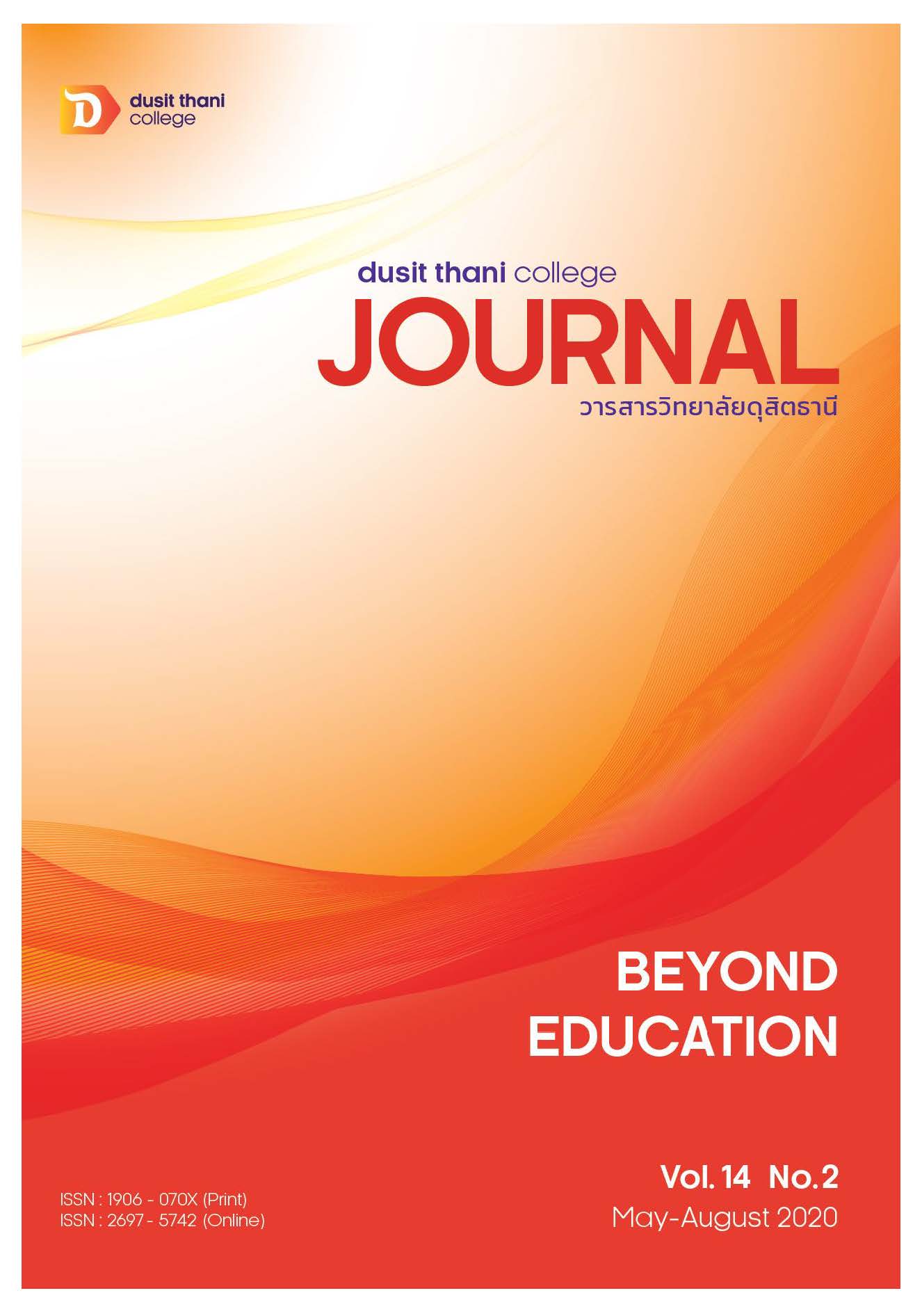Opportunities and Challenges of Hotel and Resort Spa Business to Linkage Service with Wellness Tourism in Phuket
Main Article Content
Abstract
The objectives of the study are to (1) explore the current situation of spa service linkage with wellness tourism in Phuket, and (2) investigate the opportunities and challenges of hotel and resort spa business in order to link their services with wellness tourism in Phuket. Purposive sampling was used to select the 54 representatives from hotel and resort spa, wellness tourism business, hospital/clinic and academicians. Interview and record forms were utilized for research tools. Interview, focus group and community hearing were used for data collection, then content analysis was used.
The findings found that (1) at present, the main target market are from China, Russia and Europe, followed by Australia, America, Middle East, Scandinavia, Hong Kong, Singapore, Japan, and ASEAN, respectively. The most popular spa service is Thai massage and oil massage. There are some degree of service linkage between departments in hotels and resorts. For example, F&B department offers healthy food when recreation department offers sport for health and yoga. Therefore, most of the service linkage between spa, wellness services, and holistic health tourism has been occurred within the hotel or resort. The linkage between spa and medical tourism business were only in the form of the recommendation for reliable spa service when the medical service provider cannot operate the spa by themselves due to the limitation of the international accreditation standard for hospital. (2) Linkage opportunities include health trend, the accessibility of hotel and resort spa to other wellness tourism business and the use of Thai traditional medicine and herb in holistic wellness when the linkage challenges are the accessibility of hotel and resort spa from medical tourism business, lack for strong cooperation between wellness tourism partners, lack of database on health tourist behaviour in Phuket and IT system.
Article Details
Article Screening Policy
- All research and academic articles to be published must be considered and screened by three peer reviews in the relevant field / article.
- All articles, texts, illustrations and tables published in the journal are the personal opinions of the authors. Editors don't always have to agree. And no responsibility whatsoever is the sole responsibility of the author.
- The articles to be published must never be published. Where did you first publish? And not in the consideration of other journals If the audit found that there has been a duplicate publication It is the sole responsibility of the author.
- Any article that the reader sees as being plagiarized or impersonated without reference. Or mislead the work of the author Please let the journal editor know it will be your greatest blessing.
References
Hotels and Resorts in Phuket Province in order to support the ASEAN Economic Community. Dissertation, Doctor of Philosophy Program in Hotel and Tourism Management. Phayao University.
Department of Health Service Support. (2016). Spa Business Guide. Retrieved July 5, 2018,
Available from: https://hss.moph.go.th/fileupload_doc_slider/2016-12-08--438.pdf
Department of Trade Negotiations. (2011). Business Service: Spa and Thai Massage.
Retrieved July 5, 2018, Available from: http://mdh.hss.moph.go.th/uploadFiles/document/ D00000001019_25101.pdf
Global Spa Summit (2011). Wellness Tourism and Medical Tourism: Where do Spas Fit?
Retrieved from: http://www.globalwellnesssummit.com/images/stories/pdf /spas_wellness_ medical_ tourism_report_final.pdf
Global Spa Summit and SRI International. (2010). Spas and the Global Wellness Market:
Synergies and Opportunities. Retrieved May 1, 2010, from http://www.sri.com/sites/
default/files /publications/gss_sri_spasandwellnessreport_rev_82010.pdf.
Jancharoenwong. S. 2009. Medical Tourism Strategies for Thailand. Thesis, M.B.A.,
Hospitality and Tourism Management. Prince of Songkla University.
Kanitinsutthithong, N. (2015). Factors in choosing medical tourism service In Thailand.
Dissertation, Doctoral Degree. Rajamangala University of Technology Rattanakosin.
Leelawatthananun, N. (2016). Health Tourism, Tourism Economic Review. Issue 3 Jan- Mar 2016.
Miller, G., & Foster, L. T. (2010). Critical synthesis of wellness literature.
Müller, H., & Kaufmann, E. L. (2000). Wellness Tourism: Market Analysis of a Special Health
Tourism Segment and Implication for the Hotel Industry’, Journal of Vacation
Marketing, 7(1), 5 - 17.
Pitikaisorn, Poonwatchara. (2019). Hotel spa Opportunity for Business Win-Win. Retrieved July 5, 2019, Available from: https://www.scbeic.com/th/detail/product/4383
Pornphatu Rupjumlong. (2006). Policy Framework for Health / Wellness Tourism Promotion.
Doctor of Philosophy Program in Public Administration, Ph.D. (Public Administration).
National Institute of Development Administration.
SCB Economic Intelligence Center (SCB EIC). (2017). The Global Wellness Market is High Growing in the Asia region by 14% per Year. Retrieved July 11, 2018,
Available from: http://www.komchadluek.net/news/economic/261483
Smith, M., & Puczkó, L. (2008). Health and wellness tourism. Routledge.
Sonpiam, Sasithorn. (2016). Medical tourism in Thailand : A cross-cultural study of medical tourists' decision-making factors. Thesis, M.B.A., Hospitality and Tourism Management. Prince of Songkla University.
TAT Review. (2015). ILTM 2014 : Health is a new Wealth & More. Retrieved July 5, 2018,
Available from: https://tatreviewmagazine.files.wordpress.com/2015/04/tat22015.pdf
Thai Health Promotion Foundation. (2016). Thai Massage Health Development Guide.
Retrieved from: July 5, 2018, Available from: http://resource.thaihealth.or.th/
library/hot/15403
The Office of SMEs Promotion. (2014). Healthcare Business Overview in Thailand.
Retrieved July 5, 2018, Available from: 02-003%20Healthcare%20Service.PDF
Voigt C., Brown, G., & Howat, G. (2011). Wellness tourists: in search of transformation. Tourism
Review of AIEST - International Association of Scientific Experts in Tourism, 66(1/2), 16 - 30.
Voigh, C. (2013). Wellness Tourism: A Critical Overview. Retrieved 12 June 2017, from
http://www.tobewell.eu/media/universityofexeter/businessschool/documents/research/tobewell/Wellness_Tourism_-_Cornelia_Voigt.pdf
Weiermair,K. and Steinhauser, C. (2003). NEW TOURISM CLUSTERS IN THE FIELD OF SPORTS
ANDHEALTH; THE CASE OF ALPINE WELLNESS. 12th International Tourism and Leisure
Symposium, Barcelona, April 2003.
Wildwood, Chrissie. (1997). Aromatherapy. London: Bloomsbury Publishing Plc. 33(1) 74 - 77.


